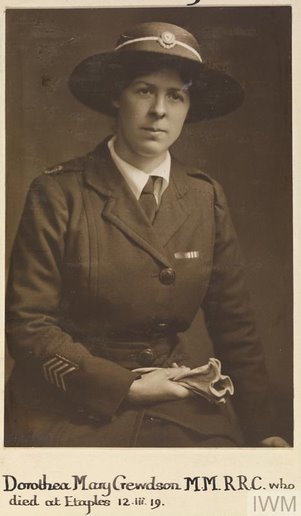24 December 2021
Researching your World War family History
Ever wondered what your family did in the two World Wars? Did they serve overseas with Commonwealth forces, protect vital shipping routes, stand guard on the home front, or something else? Simon Bendry, Head of Education and Engagement for the CWGC, uncovers a series of stories he’s found by using our ‘How to research…’ guides, which take you, step-by-step, through the process of discovering more about those who fought and died.

As part of an expansion of our ‘How to research…’ guides, we’ve created a new Guide to help people research a woman who died in World War One.
The CWGC commemorates nearly 3,000 women who died during the Two World Wars. They include pilots, SOE operatives, nurses, and mechanics. Women served in many roles on the battlefields and on active service all over the globe.
One of the earliest female casualties in our war records is Minnie Bailey Thompson, a staff nurse with the Territorial Force Nursing Service. Our records show that at the time of her death, Staff Nurse Thompson was serving with the 2nd London General Hospital and that she died on 18 September 1914. She was buried in Brompton Cemetery, with full military honours. Given the date of her death, it seems likely that she was the first military nurse to die on active service during World War One. Using the Guide, other websites then provide a little more information about Minnie, including that she died of ‘sickness’.

Dorothea Crewdson
As well as professional military nurses, the CWGC also commemorates nearly two hundred women who served with the Voluntary Aid Detachment. One of these was Dorothea Mary Lynette Crewdson. Our records show that Dorothea was the daughter of Henry and Margaret Crewdson, of Nottingham. Dorothea died on 12 March 1919 and is buried at Etaples Military Cemetery in France.
During World War One, the area around Etaples was the scene of large concentrations of reinforcement camps and hospitals. Well away from the German guns, the area was still at risk from bombing raids. By following the steps in the Guide and searching elsewhere, we can discover that Dorothea worked at No.24 General Hospital at Etaples as a nursing sister and had served in France since 1915.
In the summer of 1918, she was on duty when German bombers raided the area. For her conduct during an air-raid, Dorothea was awarded the Military Medal, ‘for gallantry and devotion to duty during an enemy air raid. Although herself wounded, she remained at duty and assisted in dressing the wounds of patients.’ She would later be appointed as an Associate of the Royal Red Cross (ARRC).
A search of the CWGC records suggests that Dorothea is the only individual commemorated by the CWGC to have been awarded the MM and the ARRC, both awards being recorded on her headstone.

Tower Hill Memorial, London.
Additional resources
Another way of making good use of the ‘How to research…’ guides, is to use them in unison with others in the series. When it comes to researching women, it is important to refer to the guides for the branch of service, for example, also using the Navy research guide for those women who served with the Women’s Royal Naval Service in World War One.
By using the two research guides together we can discover much about their service. Away from the Armed Forces, it is those women who served and died in service with merchant fleet who are commemorated in large numbers by the CWGC.
On the Tower Hill Memorial in London, are the names of 55 women who died serving in the Mercantile Marine in World War One. The oldest female merchant sailor to die in World War One is commemorated here. This is 66-year-old Eliza Kennedy, a stewardess from Tranmere who died on 4 September 1915. CWGC war records for merchant sailors show the ship on which they were sailing at the time of death.
This information really helps add to the story, especially when limited personal information is available. We know that Eliza was serving aboard the RMS Hesperian, a passenger liner working the Liverpool – Quebec – Montreal route. Research online tells us that the Hesperian was torpedoed in the Irish Sea on the night of 4 September 1915, shortly after leaving Liverpool. The ship sank slowly, meaning that there were few casualties. However, tragically one lifeboat capsized while being lowered, leading to 32 deaths, including Eliza Kennedy.

Whoever you are researching, do take a look at our ‘How to research... ' guides to help you find out more.
Explore our guides

